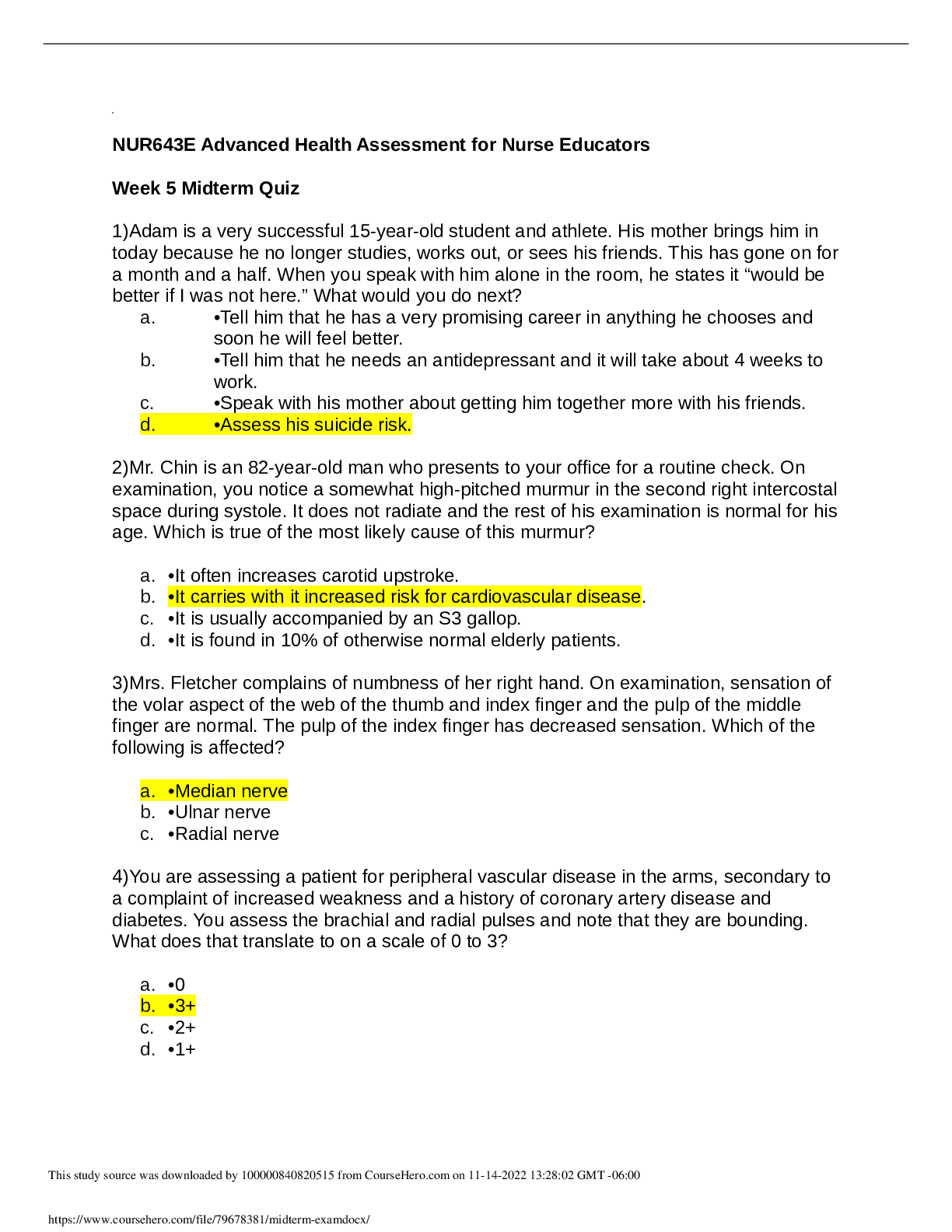Philosophy > QUESTIONS & ANSWERS > PHL 320 FINAL EXAM 2017 (All)
PHL 320 FINAL EXAM 2017
Document Content and Description Below
1. An automobile company decides to do its bit for the environment by introducing new models of electric cars. The company’s long-term goal is to eventually stop manufacturing gasoline cars and focu... s on manufacturing electric cars. The managers of the company reached this decision after critically evaluating the effects of car fluids and car emissions on the environment. They promise to do everything within their power to reduce the company’s carbon footprint. Which of the following approaches does this scenario illustrate? The defensive approach The obstructionist approach The egoistic approach The accommodative approach 2. Which of the following takes place in the final stage of the decision-making process? Ranking the various alternatives in order of practicality Examining why any expectations for a decision were not met Giving middle managers sufficient resources to achieve a goal Making minor decisions related to the chosen alternative 3. Which of the following is the first step in the decision-making process? Generating alternatives for a decision Realizing the need for a decision Assessing alternatives Seeking feedback 4. Which of the following terms refers to an approximate assessment of the credibility of a claim? Hypothetical imperative Initial plausibility Background information Categorical imperative 5. Which of the following is a practice that would help foster creativity in an organization? Withholding feedback, regardless of whether it is constructive or unconstructive Rewarding employees who come up with innovative ideas Holding on to unproductive ideas instead of eliminating them Avoiding the use of contests to encourage employees for fear of promoting unhealthy competition 6. A cosmetics company has manufactured a new range of skin care products. The top management wants to create a common tagline for the entire range of products and therefore decides to get the managers of the company involved in the decision-making process. It conducts a number of sessions in which the managers are asked to work together and think of innovative taglines for the products and share their ideas with the rest of the group. Group members are specifically asked to be open to all ideas, however offbeat they may be. The members of the group are then asked to pick a tagline after debating the pros and cons of the most popular ideas. This scenario illustrates __________. the nominal group technique the Delphi technique brainstorming Delayering 7. The top management of a cereal manufacturing company wants to change the packaging of their products and appeal to attract a younger age group. Since the company is located in three cities, the top management wants the managers from each city to weigh in and give their suggestions for improvement. A group leader is first picked, and the problem to be solved is written down. After this, a questionnaire is e-mailed to all the participating managers. The managers are asked to list down solutions to the problem and e-mail the questionnaire back to the group leader. This scenario illustrates the first few steps of __________. the nominal group technique the Delphi technique brainstorming production blocking 8. __________ are often considered to be the most critical stakeholder group. Managers Employees Customers Suppliers 9. Which of the following rules of ethical decision making focuses on providing the greatest good for the greatest number of people? The justice rule The golden rule The utilitarian rule The moral rights rule 10. __________ is a written approach to creative problem solving and decision making. The nominal group technique Brainstorming The Delphi technique Groupthink 11. In which of the following approaches to social responsibility do managers often put their own interests first and cause other stakeholders to be harmed yet manage to stay within the law and abide by legal requirements? The accommodative approach The obstructionist approach The proactive approach The defensive approach 12. When would an argument be considered valid? When it is impossible for the premise to be true and the conclusion to be false When the premise of the argument is unquestionably true When the argument is sound When it is impossible for the conclusion to appear after the premise 13. Which of the following is the final step in the decision-making process? Learning from feedback Generating alternatives [Show More]
Last updated: 2 years ago
Preview 1 out of 8 pages
.png)
Buy this document to get the full access instantly
Instant Download Access after purchase
Buy NowInstant download
We Accept:

Reviews( 0 )
$30.00
Can't find what you want? Try our AI powered Search
Document information
Connected school, study & course
About the document
Uploaded On
Jul 19, 2022
Number of pages
8
Written in
Additional information
This document has been written for:
Uploaded
Jul 19, 2022
Downloads
0
Views
66


.png)







 answers.png)


